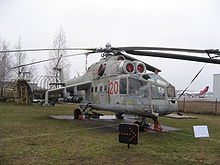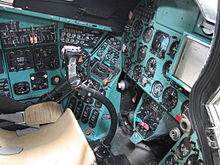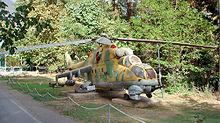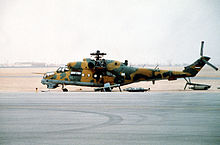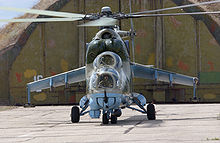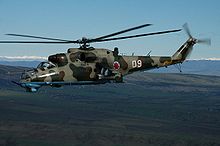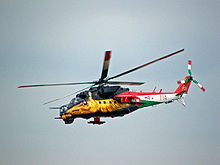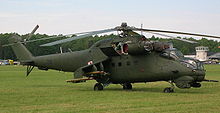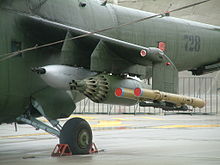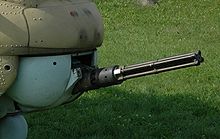- Mil Mi-24
-
Mi-24 / Mi-25 / Mi-35 Polish Mil Mi-24 Role Attack helicopter with transport capabilities National origin Soviet Union Manufacturer Mil First flight 19 September 1969 Introduction 1972 Status Active Primary users Russian Air Force
ca. 50 other users (see Operators section)Number built 2,000 (estimated) Developed from Mil Mi-8 Developed into Mil Mi-28 The Mil Mi-24 (Russian: Миль Ми-24, NATO reporting name: Hind) is a large helicopter gunship and attack helicopter[1] and low-capacity troop transport with room for 8 passengers. It is produced by Mil Moscow Helicopter Plant and operated since 1972 by the Soviet Air Force, its successors, and by over thirty other nations. In NATO circles the export versions, Mi-25 and Mi-35, are denoted with a letter suffix as "Hind D" and "Hind E" respectively. Soviet pilots called the aircraft "flying tank", or летающий танк (letayushchiy tank). More common unofficial nicknames were "Crocodile" ( Крокодил or Krokodil) due to the helicopter's camouflage scheme[2] and "Glass" (Стакан or Stakan) because of the flat glass plates which surround the cockpit of the Mi-24.
Development
During the early 1960s, it became apparent to Soviet designer Mikhail Leont'yevich Mil that the trend towards ever-increasing battlefield mobility would result in the creation of flying infantry fighting vehicles, which could be used to perform both fire support and infantry transport missions. The first expression of this concept was a mock-up unveiled in 1966 in the experimental shop of the Ministry of Aircraft's factory number 329 where Mil was head designer. The mock-up designated V-24 was based on another project, the V-22 utility helicopter, which itself never flew. The V-24 was similar in layout and configuration to the UH-1A Huey,[citation needed] with a central infantry compartment that could hold eight troops sitting back to back, and a set of small wings positioned to the top rear of the passenger cabin, capable of holding up to six missiles or rockets and a twin-barreled GSh-23L cannon fixed to the landing skid.
Mil proposed the design to the heads of the Soviet armed forces, and while he had the support of a number of strategists, he was opposed by several more senior members of the armed forces who believed that conventional weapons were a better use of resources. Despite the opposition, Mil managed to persuade the defence minister's first deputy, Marshal Andrey A. Grechko, to convene an expert panel to look into the matter. While the panel's opinions were mixed, supporters of the project eventually held sway and a request for design proposals for a battlefield support helicopter was issued. The development of gunships and attack helicopters by the US Army during the Vietnam War convinced the Soviets of the advantages of armed helicopter ground support doctrine, which had a positive influence on moving forward with the development of the Mi-24.[3]
Mil engineers prepared two basic designs: a 7-ton single-engine design and a 10.5-ton twin-engine design, both based on the 1,700 hp Izotov TV3-177A turboshaft. Later, three complete mock-ups were produced, along with five cockpit mock-ups to allow the pilot and weapon station operator positions to be fine-tuned.
The Kamov bureau suggested an army version of their Ka-25 Hormone ASW helicopter as a low-cost option. This was considered but later dropped in favor of the new Mil twin-engine design. A number of changes were made at the insistence of the military, including the replacement of the 23 mm cannon with a rapid-fire heavy machine gun mounted in a chin turret, and the use of the 9K114 Shturm (AT-6 Spiral) anti-tank missile.
A directive was issued on 6 May 1968 to proceed with development of the twin-engine design. Work proceeded under Mil until his death in 1970. Detailed design work began in August 1968 under the codename Yellow 24. A full scale mock-up of the design was reviewed and approved in February 1969. Flight tests with a prototype began on 15 September 1969 with a tethered hover, and four days later the first free flight was conducted. A second prototype was built, followed by a test batch of ten helicopters.
Acceptance testing for the design began in June 1970, continuing for 18 months. Changes made in the design addressed structural strength, fatigue problems and reduced vibration levels. Also, a 12-degree anhedral was introduced to the wings to address the aircraft's tendency to Dutch roll at speeds in excess of 200 km/h, and the Falanga missile pylons were moved from the fuselage to the wingtips. The tail rotor was moved from the right to the left side of the tail, and the rotation direction reversed. The tail rotor now rotated up on the side towards the front of the aircraft, into the downwash of the rotor, which increased the efficiency of the tail rotor. A number of other design changes were made until the production version Mi-24A (izdeliye 245) entered production in 1970, obtaining its initial operating capability in 1971 and was officially accepted into the state arsenal in 1972.[4]
In 1972, following completion of the Mi-24, development began on a unique attack helicopter with transport capability. The new design had a reduced transport capability (3 troops instead of 8) and was called the Mi-28, and that of the Ka-50 attack helicopter, which is smaller and more maneuverable and does not have the large cabin for carrying troops. In October 2007, the Russian Air Force announced it would replace its 250 Mi-24 helicopter gunships with 300 more modern Mi-28s and possibly Ka-50s by 2015.[5][6]
Design
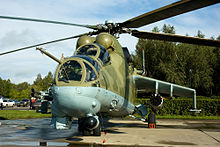 Russian Air Force Mi-24P
Russian Air Force Mi-24P
The core of the aircraft was derived from the Mil Mi-8 (NATO reporting name "Hip"): two top-mounted turboshaft engines driving a mid-mounted 17.3 m five-blade main rotor and a three-blade tail rotor. The engine configuration gave the aircraft its distinctive double air intake. Original versions have an angular greenhouse-style cockpit; Model D and later have a characteristic tandem cockpit with a "double bubble" canopy. Other airframe components came from the Mi-14 "Haze". Two mid-mounted stub wings provide weapon hardpoints, each offering three stations, in addition to providing lift. The load-out mix is mission dependent; Mi-24s can be tasked with close air support, anti-tank operations, or aerial combat.
The body is heavily armored and can resist impacts from .50 caliber (12.7 mm) rounds from all angles, including the titanium rotor blades.[citation needed] The cockpit is an even more heavily armored titanium tub and can resist impact from 37mm cannon rounds.[citation needed] The cockpit and crew compartment are overpressurized to protect the crew in NBC conditions.
Considerable attention was given to making the Mi-24 fast. The airframe was streamlined, and fitted with retractable tricycle undercarriage landing gear to reduce drag. The wings provide considerable lift at high speed, up to a quarter of total lift. The main rotor was tilted 2.5° to the right from the fuselage to counteract dissymmetry of lift at high speed and provide a more stable firing platform. The landing gear was also tilted to the left so the rotor would still be level when the aircraft was on the ground, making the rest of the airframe tilt to the left. The tail was also asymmetrical to give a side force at speed, thus unloading the tail rotor.[7]
A modified Mi-24B, named A-10, was used in several speed and time to climb world record attempts. The helicopter had been modified to reduce weight as much as possible, and among the measures used was to remove the stub wings.[4] The speed record over a closed 1000 km course set on 13 August 1975 of 332.65 km/h still stands, as does many of the female specific records set by the all female crew of Galina Rastorgoueva and Ludmila Polyanskaia.[8] On 21 September 1978 the A-10 set the absolute speed record for helicopters with 368.4 km/h over a 15/25 km course. The record stood until 1986 when it was broken by the current record holder, a modified Westland Lynx.[9]
Comparison to Western helicopters
As a combination gunship and troop transport, the Mi-24 has no direct NATO counterpart. While UH-1 ("Huey") helicopters were used in the Vietnam War either to ferry troops, or were used as gunships, they were not able to do both at the same time. Converting a UH-1 into a gunship meant stripping the entire passenger area to accommodate extra fuel and ammunition, and removing its troop transport capability. The Mi-24 was designed to do both, and this was greatly exploited by airborne units of the Soviet Army during the 1980–89 Soviet war in Afghanistan. The closest Western equivalent was the Sikorsky S-67 Blackhawk, which used many of the same design principles and was also built as a high-speed, high-agility attack helicopter with limited troop transport capability;[1] it, like the Mi-24, was also designed using many components from an already existing product, the Sikorsky S-61. The S-67, however, was never adopted for service. Another relatively close western equivalent is the US MH-60L Direct Action Penetrator, a special purpose variant of the UH-60 Black Hawk which is capable of mounting a variety of weapons on its stub wings, including AGM-114 Hellfire missiles and Hydra 70 rockets.
Operational history
Ogaden War (1977–1978)
The first use of the Mi-24 in combat was with the Ethiopian forces during the Ogaden War against the Somalis. The helicopters formed part of a massive airlift of military equipment from the Soviet Union, after the Soviets switched sides towards the end of 1977. The helicopters were instrumental in the combined air and ground assault that expelled Somali forces from Ethiopia by the beginning of 1978.[10]
Cambodian-Vietnamese War (1978)
The Mi-24A was extensively used by the Vietnam People's Air Force in the Cambodian-Vietnamese War. The gunships destroyed many Khmer Rouge bases and outposts up until 1986, when KR forces were driven to the border of Thailand.
Chadian-Libyan conflict (1978–1987)
See also: Toyota War and Operation Mount Hope IIIThe Libyan air force actively used Mi-24A and Mi-25 units during their numerous interventions in Chad's civil war.[11] The Mi-24s were first used in October 1980 in the battle of N'Djamena where they helped the People's Armed Forces seize the capital.
In March 1987 the Armed Forces of the North, which were backed by the USA and France, managed to seize a Libyan air force base at Ouadi-Doum in Northern Chad. Among the aircraft captured during this raid were three Mi-25s. These were turned over to France, which in turn sent one to the United Kingdom and one to the USA.[4]
Soviet war in Afghanistan (1979–1989)
The aircraft was operated extensively during the Soviet war in Afghanistan, mainly for bombing Mujahideen fighters. The U.S. supplied heat-seeking Stinger missiles to the Mujahideen, and the Soviet Mi-8 and Mi-24 helicopters proved to be favorite targets of the rebels.
First deployment and combat
Mi-24s were supplied to the Afghan government in April 1979 to deal with Mujahideen guerrillas.[12] The Afghan pilots were well-trained and made effective use of their machines, but the Mujahideen were not easy targets. The first Mi-24 to be lost in action was shot down by guerrillas on 30 May 1979. The situation in Afghanistan grew worse and on 25 December 1979, Soviet troops were committed to the war.
After a brutal learning curve in the face of Afghan rebels, Mi-24 pilots learned to be dangerous themselves, and the rebels called the Mi-24 "Shaitan-Arba" (Satan's Chariot)".[12] In one case, an Mi-24 pilot who was out of ammunition managed to rescue a company of infantry by maneuvering aggressively towards Mujahideen guerrillas and scaring them off. The Mi-24 was popular with ground troops, since it could stay on the battlefield and provide fire as needed, while "fast mover" strike jets could only stay for a short time before heading back to base to refuel.
The Mi-24's favoured munition was the 80-millimetre (3.1 in) S-8 rocket, the 57 mm (2.2 in) S-5 having proven too light to be effective. The 23 mm (0.91 in) gun pod was also popular. Extra rounds of rocket ammunition were often carried internally so that the crew could land and self-reload in the field. The Mi-24 could carry ten 100-kilogram (220 lb) iron bombs for attacks on strongpoints, while harder targets could be dealt with a load of four 250-kilogram (550 lb) or two 500-kilogram (1,100 lb) iron bombs. Some Mi-24 crews became experts at dropping bombs precisely on targets. Fuel-air explosive bombs were also used in a few instances, though crews initially underestimated the sheer blast force of such weapons and were caught by shock waves.
Combat experience quickly demonstrated the disadvantages of having a Mi-24 carrying troops. Gunship crews found the soldiers a concern and a distraction while being shot at, and preferred to fly lightly loaded anyway, especially given their operations from high ground altitudes in Afghanistan. Mi-24 troop compartment armour was often removed to reduce weight. Troops would be carried in Mi-8 helicopters while the Mi-24s provided fire support.
It did prove useful to carry a technician in the Mi-24's crew compartment, handling a light machine gun in a window port. This gave the Mi-24 some ability to "watch its back" while leaving a target area. In some cases a light machine gun was fitted on both sides to allow the technician to move from one side to the other without having to take the machine gun with him.
This weapon configuration still left the gunship blind to the direct rear, and Mil experimented with fitting a machine gun in the back of the fuselage, accessible to the gunner through a narrow crawl-way. The experiment was highly unsuccessful, as the space was cramped, full of engine exhaust fumes, and otherwise unbearable. During a demonstration, an overweight Soviet Air Force general got stuck in the crawl-way.[4] Operational Mi-24s were retrofitted with rear-view mirrors to help the pilot spot threats and take evasive action.
The Mi-24s not only protected helicopter troop assaults and supported ground actions; they also protected convoys, using rockets with flechette warheads to drive off ambushes, performed strikes on predesignated targets, and engaged in "hunter-killer" sweeps. The hunter-killer Mi-24s operated in pairs at minimum, more often groups of four or eight, to provide mutual fire support. The Mujahideen learned to move mostly at night to avoid the gunships, and in response the Soviets trained their Mi-24 crews in night-fighting, dropping parachute flares to illuminate potential targets for attack. The Mujahideen quickly caught on and scattered as quickly as possible when Soviet target designation flares were lit nearby.
High attrition rates
Gunship attrition rates were high.[12] The environment itself, dusty and often hot, was rough on the machines; dusty conditions led to the development of the PZU air intake filters. And of course, the rebels fought back whenever they could. Their primary air-defence weapons early in the war were heavy machine guns and anti-aircraft cannons, though anything smaller than a 23 millimetre gun generally did not do much to the Mi-24. The cockpit glass panels were resistant to 12.7 mm (0.5 in) rounds.
The rebels also used a number of Soviet made shoulder-launched, heat-seeking SAMs, which had either been captured from the Soviets or their Afghan allies or were supplied from Western sources. Many of them came from stocks the Israelis had captured during their wars with Soviet client states in the Middle East. However, owing to a combination of the limited capabilities of these early types of missiles, poor training and poor material condition of the missiles, they were not particularly effective.
The CIA then began supplying the Afghan rebels with newer Stinger shoulder-launched, heat-seeking SAMs,[13] and the situation got considerably worse for Mi-24 crews. The Stinger missile locked on to infra-red emissions from the aircraft, particularly engine exhaust, and was resistant to interference from decoy flares. Countermeasure flares and a missile warning systems were later installed in all Soviet Mi-2, Mi-8, and Mi-24 helicopters, giving pilots a chance to evade the missile. Heat dissipaters were also fitted to exhausts to decrease the Mi-24's heat signature. These reduced the Stinger threat but did not eliminate it.
Mi-24s were also used to shield jet transports flying in and out of Kabul from Stingers. The gunships carried flares to blind the heat-seeking missiles, and if worse came to worst, were under orders to try to take the hit from the missile themselves.[citation needed] The crews called themselves "Mandatory Matrosovs", after a Soviet hero of the Second World War who threw himself across a German machine gun to let his comrades break through.
Mi-24 crews and end of Soviet involvement
Mi-24 crews carried AK-74 and other hand-held weapons to give them a better chance of survival if forced down.[12] Early in the war, head of Mil Marat Tischenko visited Afghanistan to see what the troops thought of his helicopters, and gunship crews put on several displays for him. They even demonstrated maneuvers such as barrel rolls, which design engineers considered impossible. An astounded Dr. Tischenko commented, "I thought I knew what my helicopters could do, now I'm not so sure!"[12]
A Mi-24 was shot down during the night of 2 February 1989, with both crewmen killed. It was the last Soviet Mi-24 lost during nearly ten years of warfare.
Mi-24s in Afghanistan after Soviet withdrawal
Mi-24s passed on to pro-Soviet Afghan forces during the war remained in dwindling service in the grinding civil war that continued after the Soviet withdrawal.[12] Some were flown by defectors to Pakistan, and a few of these machines apparently found their way into the hands of the US Army.[citation needed]
Afghan Mi-24s in the hands of the ascendant Taliban gradually became inoperable, but a few flown by the Northern Alliance, which had Russian assistance and access to spares, remained operational up to the U.S. invasion of Afghanistan in the fall of 2001. In 2008, the Afghan National Air Corps took delivery of six refurbished Mi-35 helicopters, purchased from the Czech Republic with U.S. money. The Afghan pilots were trained by India and began live firing exercises in May 2009 in order to escort Mi-17 transport helicopters on operations in restive parts of the country.
Iran–Iraq War (1980–1988)
The Mi-25 saw considerable use by the Iraqi Army during the long war against Iran.[14] Its heavy armament was a key factor in causing severe damage to Iranian ground forces during the war. However, the Mi-25s lacked an effective anti-tank capability, as they were only armed with obsolete 9M17 Skorpion missiles. This led the Iraqis to develop new gunship tactics, with help from East German advisors. The Mi-25s would form "hunter-killer" teams with French-built Aérospatiale Gazelles, with the Mi-25s leading the attack and using their massive firepower to suppress Iranian air defenses, and the Gazelles using their HOT missiles to engage armoured fighting vehicles. These tactics proved effective in halting Iranian offensives, such as Operation Ramadan in July 1982.[15]
This war also saw the only confirmed air-to-air helicopter battles in history with the Iraqi Mi-25s flying against Iranian AH-1J SeaCobras (supplied by the United States before the Iranian Revolution) on several separate occasions. Not long after Iraq's initial invasion of Iran on 22 September 1980, two Iranian SeaCobras crept up on two Mi-25s and hit them with TOW wire-guided antitank missiles.[16] One Mi-25 went down immediately, the other was badly damaged and crashed before reaching base. The Iranians pulled off a repeat performance on 24 April 1981, destroying two Mi-25s without incurring losses to themselves.
The Iraqis hit back, claiming the destruction of a SeaCobra on 14 September 1983; three SeaCobras on 5 February 1984; and three more on 25 February 1984. After a lull in helicopter losses, each side lost a gunship on 13 February 1986. Later, a Mi-25 claimed a SeaCobra shot down on 16 February, and a SeaCobra claimed a Mi-25 shot down on 18 February. The last engagement between the two types was on 22 May 1986, when Mi-25s shot down a SeaCobra. The final claim tally was 10 SeaCobras destroyed and 6 Mi-25s destroyed. The relatively small numbers and the inevitable disputes over actual kill numbers makes it unclear if one gunship had a real technical superiority over the other. Iraqi Mi-25s also claimed a total of 43 kills against other Iranian helicopters, such as Agusta-Bell UH-1 Hueys.[16]
In general, the Iraqi pilots liked the Mi-25, in particular for its high speed, long range, high versatility and large weapon load, but disliked the relatively ineffectual weapons and lack of agility.[15] The Mi-25 was also used by Iraq in chemical warfare against Iranians and Kurdish civilians in Halabja.[16]
Nicaraguan civil war (1980–1988)
Mi-25s were also used by the Nicaraguan Army during the civil war of the 1980s.[17][18] Nicaragua received 12 Mi-24s (some sources claim 18) in the mid-1980s to deal with American-backed "Contra" insurgents.[16] The Mi-25s performed ground attacks on the Contras and were also fast enough to intercept light aircraft being used by the insurgents. The U.S. Reagan Administration regarded introduction of the Mi-25s as a major escalation of tensions in Central America.
Two Mi-25s were shot down by Stingers fired by the Contras. A third Mi-25 was damaged while pursuing Contras near the Honduran border, when it was intercepted by Honduran F-86 Sabres and A-37 Dragonflies. A fourth was flown by a defecting Sandinista pilot to Honduras in December 1988.
Sri Lankan Civil War (1987–2009)
The Indian Peace Keeping Force (1987–90) in Sri Lanka used Mi-24s when an Indian Air Force detachment was deployed there in support of the Indian and Sri Lankan armed forces in their fight against various Tamil militant groups such as the LTTE. It is believed that Indian losses were considerably reduced by the heavy fire support provided by their Mi-24 gunships. The Indians lost no Mi-24s in the operation, as the Tigers had no weapons capable of dealing with the Crocodile at the time,[16][19] although several sustained heavy damage from machine gun fire.
Since 14 November 1995, the Mi-24 has been used by the Sri Lanka Air Force in the war against the LTTE and has proved highly effective providing close air support for ground forces. The Sri Lanka Air Force currently operates a mix of Mi-24/-35P and Mi-24V/-35 versions attached to its No. 9 Attack Helicopter Squadron. They have recently been upgraded with modern Israeli FLIR and electronic warfare systems. Five were upgraded to intercept aircraft by adding radar, fully functional helmet mounted target tracking systems, and AAMs. More than 5 Mi-24s have been lost to LTTE MANPADs, and another two lost in attacks on airbases, with one heavily damaged but later returned to service.[19]
Persian Gulf War (1991)
The Mi-24 was also heavily employed by the Iraqi Army during their invasion of Kuwait, although most were withdrawn by Saddam Hussein when it became apparent they would be needed to help retain his grip on power in the aftermath of the war. In the ensuing 1991 uprisings in Iraq, these helicopters were used against dissidents as well as fleeing civilian refugees.[20][21]
A few Mi-24s were later sent over the border into Iran, along with many other Iraqi military aircraft, in the hope of sparing them from destruction by allied air strikes.[citation needed] Some Mi-24 were captured and later sent to the U.S. and operated by OPTEC/OTSA in Fort Bliss and Fort Irwin.[citation needed]
Sierra Leone Civil War (1991–2002)
Three Mi-24Vs owned by Sierra Leone and flown by South African military contractors, including Neall Ellis, were used against RUF rebels.[22] In 1995, they helped drive the RUF from the capital, Freetown.[23] Guinea also used its Mi-24s against the RUF on both sides of the border and was alleged to have provided air support to the LURD insurgency in northern Liberia in 2001–03.
Croatian War of Independence (1990s)
First unveiled in Croatia in 1993, twelve Mi-24s were effectively used in 1995 by the Croatian Army in Operation Storm against Krajina army paramilitaries. The Mi-24 was used to strike deep into the enemy background and paralyze Krajina army communications and command. The actions of Mi-24 were successful and one Croatian Mi-24 crashed near city of Drvar, Bosnia & Herzegowina due to strong winds, both the pilot and the operator survived. The Mi-24 used by the Croatia armed forces were obtained from Ukraine. Years of misuse, lack of spare parts and regular maintenance have grounded all of the Mi-24.
First and Second Wars in Chechnya (1990s–2000s)
During the First and Second Chechen Wars, beginning in 1994 and 1999 respectively, Mi-24s were employed by the Russian armed forces. As in Afghanistan, the Mi-24s were vulnerable to rebel tactics. No less than two dozens crashed or were shot down during military operations.
Cenepa War (1995)
Peru employed Mi-25s against Ecuadorian forces during the short Cenepa conflict in early 1995. The only loss occurred on 7 February, when a FAP Mi-25 was downed after being hit in quick succession by at least two – probably three – Strela shoulder-fired missiles during a low-attitude mission over the Cenepa valley. The three crewmen were killed.[citation needed]
Sudanese Civil War (1995–2005)
In 1995, the Sudanese Air Force acquired six Mi-24s for use in Southern Sudan and the Nuba mountains to engage the SPLA. At least two aircraft were lost in non-combat situations within the first year of operation. A further twelve were bought in 2001,[24] and used extensively in the oil fields of Southern Sudan. Mi-24s were also deployed to Darfur in 2004–5.
First and Second Congo Wars (1996–2003)
Three Mi-24s were used by Mobutu's army and were later acquired by the new Air Force of the Democratic Republic of the Congo.[25] These were supplied to Zaire in 1997 as part of a French-Serbian contract. At least one was flown by Serbian mercenaries. One hit a power line and crashed on 27 March 1997, killing the three crew and four passengers.[26] Zimbabwean Mi-24s were also operated in coordination with the Congolese Army.
The United Nations peacekeeping mission employed Indian Air Force Mi-24/-35 helicopters to provide support during the Second Congo War. The IAF has been operating in the region since 2003.[27]
Kosovo war (1998–1999)
On the night of 1 March 1998, during the fighting against Kosovo Liberation Army (KLA) forces during the Kosovo War, a Serbian Special Operations Unit (JSO) landed in the village of Prekaz. One of its Mi-24V was hit by small arms fire and made an emergency landing, but the KLA fighters were pushed back by JSO personnel. During the summer of 1998, Mi-24Vs took part in several combat missions. On 27 June, JSO forces used four helicopters to come to the aid of approximately 100 police officers who were surrounded by KLA forces. they were also used to secure Serbian civilians fleeing a NATO blockade in the village of Kijevo. The Mi-24Vs and Mi-17s transported ammunition and evacuated wounded.
Conflict in Republic of Macedonia (2001)
The Military of the Republic of Macedonia acquired used Ukrainian Mi-24Vs. They were used frequently against Albanian insurgents during the 2001 conflict in Macedonia. The main areas of action were in Tetovo, Radusha and Aracinovo.[28]
Ivorian Civil War (2002–2004)
During the Ivorian Civil War five Mil Mi-24s piloted by mercenaries were used in support of government forces. They were later destroyed by the French Army in retaliation for an air attack on a French base which killed nine soldiers.[29]
Afghanistan War (2001–present)
In 2008 and 2009, the Czech Republic donated six Mi-24 under the ANA Equipment Donation Programme. As a result, the Afghan National Army Air Corps (ANAAC) now has the ability to escort its own helicopters with heavily armed attack helicopters. Currently 9 Mi-35 attack helicopters are operated by the ANAAC. Major Caleb M. Nimmo was the first American to fly the Mi-35 Hind in combat.[30] On 13 September 2011, a Mi-35 attack chopper of the Afghan National Army was used to hold back an attack on ISAF and police buildings.[31]
Polish Helicopter Detachment contributed with Mi-24s to International Security Assistance Force (ISAF). The Polish pilots trained in Germany before deploying to Afghanistan and currently train with U.S. service personnel. On 26 January 2011, one Mi-24 caught on fire during takeoff from its base in Ghazni. One American and four Polish soldiers were able to evacuate unharmed.[32] This leaves the Polish contingent with five operational Mi-24s (three aircraft have been lost so far) and four Mi-17s.
Iraq War (March 2003–2010)
The Polish contingent in Iraq has been using six Mi-24Ds since December 2004. One of them crashed on 18 July 2006 in an air base in Al Diwaniyah.[33] Polish Mi-24Ds used in Iraq will not be returning to Poland due to their age, condition, low combat value of the Mi-24D variant, and high shipping costs; depending on their condition they will be transferred to the New Iraqi Army or scrapped. New Mi-35Ps will be bought by the Polish Army as "replacements of equipment depleted during combat operations" for the Mi-24Ds used and left in Iraq.
War in Somalia (2006–2009)
The Ethiopian Air Force operates about three Mil Mi-35 and ten Mil Mi-24D helicopter gunships in the Somalian theater. One was shot down near the Mogadishu International Airport on 30 March 2007 by Somali insurgents.[34]
War in Chad (2008)
Upon returning to Abeche, one of Chadian Mi-35 made a forced landing at the airport. It was claimed that it was shot down by rebels.[35][36]
South Ossetia war (2008)
During the 2008 South Ossetia war the Mi-24 was used by both Russia and Georgia.
Libyan civil war (2011)
The Libyan Air Force Mi-24s were used by both sides to attack enemy positions during the 2011 Libyan civil war.[37] A number have been captured by the rebels, who formed the Free Libyan Air Force together with other captured air assets. During the battle for the Benina airport, one Mi-35 (853 serial number), was destroyed on the ground on 23 February 2011. In the same action the serial number 854 was captured by the rebels together with a Mi-14 (serial number 1406).[38][39] Two Mi-35s operating for the pro-Gaddafi Libyan Air Force were destroyed on 26 March 2011 by French aircraft enforcing the no-fly zone.[40] One Free Libyan Air Force Mi-25D (854 serial number, captured at the beginning of the revolt) violated the no-fly-zone on 9 April 2011 to strike loyalist positions in Ajdabiya. It was shot down by Libyan ground forces during the action. The pilot, Captain Hussein Al-Warfali, died in the crash.[41] A number of other Mi-25s were claimed shot down by the rebels.
2010–2011 Ivorian crisis
Ukrainian army Mi-24P helicopters as part of UN peacekeeping force fired four missiles at a pro-Gbagbo military camp in Ivory Coast's main city of Abidjan.[42]
Variants
Main article: Mil Mi-24 variantsOperators
 Albania
Albania - Albanian Air Force[citation needed]
 Afghanistan
Afghanistan- Afghan Air Force has received 115 since 1979, with 6 Mi-35 operational.
 Algeria
Algeria- Algerian Air Force
 Angola
Angola- People's Air and Air Defence Force of Angola
 Armenia
Armenia- Armenian Air Force has 12 in service as of 2010.[43]
 Azerbaijan
Azerbaijan- Azerbaijani Air Forces has 15 Mi-24s in service as of January 2011 + 24 Mi-35M ordered in 2010. [44][45][46]
 Belarus
Belarus- Belarus Air Force
 Brazil
Brazil- Brazilian Air Force – 12 Mi-35Ms in service in the "2nd–8th Aviation Group" based in the Amazon region.[47][48][49]
 Bulgaria
Bulgaria- Bulgarian Air Force – 18 (12 Mi-25 and 6 Mi-35)
 Burkina Faso
Burkina Faso- Burkina Faso Air Force 2 delivered from Russia in 2005.
 Burundi
Burundi- Military of Burundi[citation needed]
 Cyprus
Cyprus- Cyprus Air Forces: 11 Mi-35Ps were in service as of 2010.
 Cuba
Cuba- Cuban Air Force – 15 Mi-24s
 Czech Republic
Czech Republic- Czech Air Force
 Djibouti
Djibouti- Air Force of Djibouti: 2 delivered from Belarus in 2005. Also Ethiopian deserters reported.
 Equatorial Guinea
Equatorial Guinea- Military of Equatorial Guinea: 5
 Eritrea
Eritrea- Eritrean Air Force
 Ethiopia
Ethiopia- Ethiopian Air Force
Georgian Air Force Mi-24
 Georgia
Georgia- Georgian Air Force had at least 12 Mi-24s prior to 2008 war with Russia.
 Guinea
Guinea- Military of Guinea
 Hungary
Hungary- Hungarian Air Force. 49, 20 from the German Army (taken over from East German Air Force)
 India
India- Indian Air Force: 1 Squadron each of Mi-25s and Mi-35s.
 Indonesia
Indonesia- Indonesian Army. Eight Mi-35 are in service.
 Iran
Iran- Iranian Air Force
 Côte d'Ivoire
Côte d'Ivoire- Côte d'Ivoire Air Force
 Kazakhstan
Kazakhstan- Military of Kazakhstan
 Kyrgyzstan
Kyrgyzstan- Military of Kyrgyzstan
 Lebanon
Lebanon- Military of Lebanon: to be delivered instead of 10 MiG-29 offered by Russia as a grant.[50]
 Libya
Libya- Libyan Air Force: 35 operated before the uprising, unknown number captured by the Free Libyan Air Force, 2 destroyed by the French Air Force.
 Libya
Libya- Free Libyan Air Force: Captured from pro-Gaddaffi forces.
 Macedonia
Macedonia- Macedonian Air Force
 Mali
Mali- Air Force of Mali 2 supplied by Bulgaria in 2007.
 Mongolia
Mongolia- Mongolian Air Force. Ordered 24 in 1984, but received 12 in 1986–87. Currently 10-20 in service.
 Mozambique
Mozambique- Military of Mozambique
 Myanmar
Myanmar- The Military of Myanmar ordered 10 Mi-35s in 2009.[51]
 Namibia
Namibia - Namibian Air Force
 Nicaragua
Nicaragua- Nicaraguan Air Force
 Niger
Niger- Air Force of Niger: Unconfirmed. May have been destroyed.
 Nigeria
Nigeria- Nigerian Air Force
 North Korea
North Korea- North Korean Air Force
 Peru
Peru- Peruvian Air Force 16 Mi-25D and 2 Mi-35P
 Poland
Poland- Polish Land Forces and Polish Air Force former operator.
- Mi-24Ds, Polish Land Forces 49th Combat Helicopter Regiment (49 Pułk Śmigłowców Bojowych) in Pruszcz Gdański
- Mi-24Ds, Polish Land Forces Independent Air Assault Group (Samodzielna Grupa Powietrzno-Szturmowa) in Al Kut and Al Diwaniyah, Iraq
- Scorpion aerobatic team
- Mi-24W(V)s, Polish Land Forces 56th Kujawian Combat Helicopter Regiment (56 Kujawski Pułk Śmigłowców Bojowych) in Inowrocław.
 Russia
Russia- 360 in service with the Russian Air Force, Russian Ground Forces, and Russian Navy.
 Rwanda
Rwanda- Military of Rwanda
 Saudi Arabia
Saudi Arabia- Royal Saudi Air Force: To order up to 30 Mi-35's.
 Senegal
Senegal- Senegalese Air Force 2 Mi-35 supplied by Russia in 2007.
 Slovakia
Slovakia- Slovak Air Force - operation of Mi-24 terminated on 21.09.2011 due to technical life
 Sri Lanka
Sri Lanka- Sri Lanka Air Force's No. 9 Attack Helicopter Squadron operates 15 Mi-24s, including Mi-24D/V/P and Mi-35.[52]
 Sudan
Sudan- Sudanese Air Force
 Syria
Syria- Syrian Air Force
 Tajikistan
Tajikistan- Military of Tajikistan
 Uganda
Uganda- Ugandan Air Force
 Ukraine
Ukraine- Ukrainian Air Force, Ukrainian Ground Forces
 United States
United States
- The Cold War Air Museum (CWAM) operates 2 Mi-24s from its Museum at Lancaster Airport just south of Dallas, Texas.[53]
- U.S. Army operates a number of Fort Bliss, Texas based Mi-24s at Louisiana's Fort Polk for adversary training.[54]
- Federal Aviation Administration registry lists 7 privately owned Mi-24s operated by civilians.[55]
 Uzbekistan
Uzbekistan- Military of Uzbekistan
 Venezuela
Venezuela- Army of Venezuela. 10 Mi-35M2
 Vietnam
Vietnam- Vietnam People's Air Force
 Yemen
Yemen- Yemen Air Force
 Zimbabwe
Zimbabwe- Air Force of Zimbabwe
Former operators
 Croatia
Croatia- Croatian Air Force. Grounded and retired.
 Czechoslovakia
Czechoslovakia- Czechoslovakian Air Force
 East Germany
East Germany- East German Air Force
 Germany
Germany- 51 inherited from East Germany were sold to Hungary, Poland and two to the U.S. Army.
 Iraq
Iraq- Iraqi Air Force
 Poland
Poland- Polish Air Force
 FR Yugoslavia
FR Yugoslavia- 2 operated by Special Operations Unit.
 Sierra Leone
Sierra Leone United States
United States- US Army OPFOR
 Soviet Union
Soviet Union- Soviet Air Force, Soviet Army Aviation
Specifications (Mi-24)
Data from Indian-Military.org[56]
General characteristics
- Crew: 2–3: pilot, weapons system officer and technician (optional)
- Capacity: 8 troops or 4 stretchers
- Length: 17.5 m (57 ft 4 in)
- Rotor diameter: 17.3 m (56 ft 7 in)
- Wingspan: 6.5 m (21 ft 3 in)
- Height: 6.5 m (21 ft 3 in)
- Disc area: 235 m² (2,530 ft²)
- Empty weight: 8,500 kg (18,740 lb)
- Max takeoff weight: 12,000 kg (26,500 lb)
- Powerplant: 2 × Isotov TV3-117 turbines, 1,600 kW (2,200 hp) each
Performance
- Maximum speed: 335 km/h (208 mph)
- Range: 450 km (280 miles)
- Service ceiling: 4,500 m (14,750 ft)
- Armament
- Internal guns
-
- flexible 12.7 mm Yakushev-Borzov Yak-B Gatling gun on most variants. Maximum of 1,470 rounds of ammunition.
- fixed twin-barrel GSh-30K on the Mi-24P. 750 rounds of ammunition.
- flexible twin-barrel GSh-23L on the Mi-24VP and Mi-24VM. 450 rounds of ammunition.
- PKT passenger compartment window mounted machine guns
- External stores
-
- Total payload is 1,500 kg of external stores.
- Inner hardpoints can carry at least 500 kg
- Outer hardpoints can carry up to 250 kg
- Wing-tip pylons can only carry the 9M17 Phalanga (in the Mi-24A-D) or the 9K114 Shturm complex (in the Mi-24V-F).
- Bomb-load
-
- Bombs within weight range (presumably ZAB, FAB, RBK, ODAB etc.), Up to 500 kg.
- MBD multiple ejector racks (presumably MBD-4 with 4xFAB-100)
- KGMU2V submunition/mine dispenser pods
- First-generation armament (standard production Mi-24D)
-
- GUV-8700 gunpod (with a 12.7 mm Yak-B + 2x7.62 mm GShG-7.62 mm combination or one 30 mm AGS-17)
- UB-32 S-5 rocket launchers
- S-24 240 mm rocket
- 9M17 Phalanga (a pair on each wingtip pylon)
- Second-generation armament (Mi-24V, Mi-24P and most upgraded Mi-24D)
-
- UPK-23-250 gunpod carrying the GSh-23L
- B-8V20 a lightweight long tubed helicopter version of the S-8 rocket launcher
- 9K114 Shturm in pairs on the outer and wingtip pylons
Popular culture
An SA-330 Puma was equipped with stub wings and a gun turret to mimic a Soviet Mi-24 in the films Red Dawn and most notably Rambo: First Blood Part II and Rambo III.[57][58] The Mi-24 features repeatedly in the 1987 novel Winter Hawk by Craig Thomas.
See also
- Related development
- Aircraft of comparable role, configuration and era
References
- ^ a b Air-to-Air Defense for Attack Helicopters
- ^ Day, Dwayne A. "Mi-24 Hind "Krokodil"". US Centennial of Flight Commission. http://www.centennialofflight.gov/essay/Rotary/Hind/HE18.htm. Retrieved 2011-07-01.
- ^ Culhane, Kevin V. (1977). "Student research report: The Soviet attack helicopter" (PDF). DTIC. http://www.dtic.mil/cgi-bin/GetTRDoc?AD=ADA067345&Location=U2&doc=GetTRDoc.pdf. Retrieved 2011-07-01.
- ^ a b c d Yefim Gordon & Dmitry Komissarov (2001). Mil Mi-24, Attack Helicopter. Airlife.
- ^ "Mi-28 Replacing Mi-24". Strategy Page. 31 October 2007. http://www.strategypage.com/htmw/htairfo/articles/20071031.aspx.
- ^ "Russia’s Air Force to Replace Combat Helicopters by 2015". Kommersant. 24 October 2007. http://www.kommersant.com/p-11581/Combat_helicopter/.
- ^ Yefim Gordon & Dmitry Komissarov (2001). Mil Mi-24 Hind, Attack Helicopter. Airlife.
- ^ "Rotorcraft World Records: List of records established by the 'A-10'". Fédération Aéronautique Internationale. http://records.fai.org/rotorcraft/aircraft.asp?id=552. Retrieved 17 September 2009.[dead link]
- ^ "Rotorcraft World Records: History of Rotorcraft World Records". Fédération Aéronautique Internationale. http://records.fai.org/rotorcraft/history.asp?id1=112&id2=28&id3=1&id4=2. Retrieved 17 September 2009.[dead link]
- ^ Cooper, Tom. "Ogaden War, 1977–1978". Air Combat Information Group (acig.org). Archived from the original on 7 January 2007. http://web.archive.org/web/20070107093450/http://www.acig.org/artman/publish/article_188.shtml. Retrieved 18 March 2007.
- ^ Yefim Gordon and Dmitry Komissarov (2001). Mil Mi-24 Hind, Attack Helicopter. Airlife.
- ^ a b c d e f Goebel, Greg (1 April 2009). "Hind Variants / Soviet Service". http://www.vectorsite.net/avhind_1.html. Retrieved 17 January 2008.
- ^ Silverstein, Ken (2 October 2001). "Stingers, Stingers, Who's Got the Stingers?". GlobalSecurity.org. http://www.globalsecurity.org/org/news/2001/011002-attack03.htm. Retrieved 8 October 2008.
- ^ Cooper, Tom; Bishop, Farzad (9 September 2003). "I Persian Gulf War: Iraqi Invasion of Iran, September 1980". Air Combat Information Group. http://www.acig.org/artman/publish/article_206.shtml.
- ^ a b Cooper, Tom; Bishop, Farzad (9 September 2003). "Fire in the Hills: Iranian and Iraqi Battles of Autumn 1982". Air Combat Information Group. http://www.acig.org/artman/publish/article_214.shtml. Retrieved 17 January 2008.
- ^ a b c d e Goebel, Greg (1 April 2009). "Hind In Foreign Service / Hind Upgrades / Mi-28 Havoc". The Mil Mi-24 Hind & Mi-28 Havoc. http://www.vectorsite.net/avhind_2.html. Retrieved 17 September 2009.
- ^ "Mi-24". Wings Palette. http://wp.scn.ru/en/ww3/v/41/179/0/4. Retrieved 2011-07-01.
- ^ "Mil Mi-24". Aerospaceweb.org. http://www.aerospaceweb.org/aircraft/helicopter-m/mi24/. Retrieved 2011-07-01.
- ^ a b Cooper, Tom (29 October 2003). "Sri Lanka, since 1971". Air Combat Information Group. http://www.acig.org/artman/publish/article_336.shtml.
- ^ Johns, Dave. "Supression of the 1991 Uprising". The Crimes of Saddam Hussein. PBS. http://www.pbs.org/frontlineworld/stories/iraq501/events_uprising.html. Retrieved 2011-07-01.
- ^ Brew, Nigel (16 June 2003). "Behind the Mujahideen-e-Khalq (MeK)". Parliament of Australia. Archived from the original on 5 August 2009. http://www.webcitation.org/5io7JDsaA.
- ^ Corcoran, Mark (28 September 2000). "Gunship for Hire". Foreign Correspondent. ABC News (Australia). http://www.abc.net.au/foreign/content/2000/s229144.htm.
- ^ Cooper, Tom; Chick, Court "Skyler" (5 August 2004). "Sierra Leone, 1990–2002". Air Combat Information Group. http://www.acig.org/artman/publish/article_462.shtml.
- ^ "Government Revenue from Oil and Expenditures on Arms". Sudan, Oil, and Human Rights. Human Rights Watch. September 2003. ISBN 1564322912. http://www.hrw.org/reports/2003/sudan1103/8.htm#_Toc54492558. Retrieved 2011-07-01.
- ^ Cooper, Tom (26 November 2004). "Mil-Helicopters in World-Wide Service, Part 1". Air Combat Information Group. http://www.acig.org/artman/publish/article_485.shtml.
- ^ Cooper, Tom; Weinert, Pit (2 September 2003). "Zaire/DR Congo since 1980". Air Combat Information Group. http://www.acig.org/artman/publish/article_190.shtml.
- ^ Datt, Gautam (27 July 2005). "More troops may go to Congo". DefenceIndia. http://www.defenceindia.com/25-jul-2k5/news19.html.[dead link]
- ^ Cooper, Tom (30 November 2003). "Macedonia, 2001". Air Combat Information Group. http://www.acig.org/artman/publish/article_384.shtml.
- ^ Bridgland, Fred (8 November 2004). "Ivory Coast descends into chaos and war". The Scotsman. UK. Archived from the original on 7 January 2008. http://web.archive.org/web/20080107010744rn_1/thescotsman.scotsman.com/ViewArticle.aspx?articleid=2578343.
- ^ Radin, CJ (July 2009). "Afghan National Security Forces Order of Battle, Afghan National Army Air Corps (ANAAC)" (PDF). The Long War Journal. http://www.longwarjournal.org/multimedia/ANSF%20OOBpage5-ANAC.pdf. Retrieved 2 October 2009.
- ^ "Taliban Attack US Embassy, Other Kabul Buildings". Associated Press. 13 September 2011. http://www.google.com/hostednews/ap/article/ALeqM5iBEIEhCzwzcJJLRzKR8NuDBa5Lhg?docId=fb3f8b69e74a48bb8edcd7d326937571.
- ^ 26-Jan-11 Mil Mi-24 Ghazni, Afghanistan | Helihub - the Helicopter Industry Data Source
- ^ "Śmigłowce Mi-24 w PKW w Iraku" (in Polish). Ministerstwo Obrony Narodowej. 24 January 2005. http://www.mod.gov.pl/artykul_wiecej.php?idartykul=786.
- ^ "Helicopter shot down in Somalia". BBC. 30 March 2007. http://news.bbc.co.uk/1/hi/world/africa/6509729.stm.
- ^ Axe, David (4 August 2008). "Chadian helicopter shot down". Demotix. http://www.demotix.com/news/chadian-helicopter-shot-down.
- ^ "Chad helicopter in 'hard landing' after air attack on rebels". AFP. Google. 12 June 2008. http://afp.google.com/article/ALeqM5jxT9k5PrWs76FrrZ06cHNBbgTycw.
- ^ "Options in Libya after UN vote", Strategic Comments, 17, IISS, 2011-3, http://www.iiss.org/publications/strategic-comments/past-issues/volume-17-2011/march/options-in-libya-after-un-vote/.
- ^ "Libia: Mi-25 destruido en Bengasi" (in Spanish) (JPEG), Blogger, Google, http://3.bp.blogspot.com/-0TLBmI085dk/TXybnxP12oI/AAAAAAAAIQQ/69e7QYk-ifI/s1600/LIBIA%2BMI-25%2B853%2BDESTRUIDO%2BBENGASI.jpg.
- ^ The Boresight, Blogger, Google, March 2011, http://theboresight.blogspot.com/2011_03_01_archive.html.
- ^ "Libye: point de situation, opération Harmattan" (in French), Actualités, Opérations, FR: Défense, http://www.defense.gouv.fr/operations/actualites/libye-point-de-situation-operation-harmattan-n-8.
- ^ Libyan Conflict, Military Photos, p. 96, http://www.militaryphotos.net/forums/showthread.php?195079-Libyan-Conflict-Photos-and-Videos/page96.
- ^ "U.N. helicopters fire on Gbagbo army camp -witnesses". Reuters. 4 April 2011. http://af.reuters.com/article/ivoryCoastNews/idAFLDE73322Z20110404.
- ^ "World Military Aircraft Inventory". 2010 Aerospace Source Book. Aviation Week and Space Technology, January 2010.
- ^ Azerbaijan buys 24 Russian attack helicopters, AZ: News, http://www.news.az/articles/politics/31940.
- ^ "‘Роствертол’ увеличил в прошлом году чистую прибыль в 3 раза" (in Russian). SU: Arms-Tass. February 23, 2011. http://arms-tass.su/?page=article&aid=93084&cid=25. Retrieved February 23, 2011.
- ^ "Azerbaijan purchased from Russia 24 Mi-35M". AZ: 1News. February 24, 2011. http://www.1news.az/politics/20110224112731122.html. Retrieved February 24, 2011.
- ^ (in Portuguese) FAB divulga novas imagens dos helicópteros AH-2 Sabre em Porto Velho, BR: Cavok, http://cavok.com.br/blog/?p=9586.
- ^ (in Portuguese) AH-2 Sabre, a nova arma da FAB, BR: AeroEntusiasta, http://www.aeroentusiasta.com.br/posts/79.
- ^ Brazilian air force fields first Mi-35M attack helicopters, Flight Global, http://www.flightglobal.com/articles/2010/04/22/340973/pictures-brazilian-air-force-fields-first-mi-35m-attack.html.
- ^ Nahmias, Roee (26 February 2010). "Report: Russia to provide Lebanon with choppers". Ynetnews. http://www.ynetnews.com/articles/0,7340,L-3855085,00.html. Retrieved 26 February 2010.
- ^ "Russia, Burma sign arms deal". 23 December 2009. http://www.mizzima.com/news/world/3200-russia-burma-sign-arms-deal.html.
- ^ "Directory: World Air Forces" (PDF). Flight International. 11–17 November 2008. http://www.flightglobal.com/assets/getasset.aspx?ItemID=26061.
- ^ "Registry of Aircraft – Mi24 – Texas". Federal Aviation Administration. http://registry.faa.gov/aircraftinquiry/mmsinqSQL.asp?mmstxt=5580103&statetxt=TX. Retrieved 2011-07-01.
- ^ Harding, Steve (June 1995). "Flying the Threat". Soldiers Magazine: p. 37. Archived from the original on 24 February 2007. http://web.archive.org/web/20070224145840/http://www.army.mil/soldiers/june95/p37.html.
- ^ "Registry of Aircraft – Mi24". Federal Aviation Administration. http://registry.faa.gov/aircraftinquiry/AcftRef_Results.aspx?Mfrtxt=MIL&Modeltxt=MI-24&PageNo=1. Retrieved 2011-07-01.
- ^ "Mil Mi-24, Mi-25, Mi-35 (Hind) Akbar". Indian-Military.org. 5 October 2009. http://www.indian-military.org/air-force/helicopters/attack/203-mil-mi-24mi-25-mi-35-hind-akbar.html. Retrieved 17 November.
- ^ Tsaganas, Costas. "Red Dawn". Rotary Action. http://www.rotaryaction.com/pages/redawn84.html. Retrieved 2011-07-01.
- ^ Decker, Nathan. "Rambo 3". Rotary Action. http://www.rotaryaction.com/pages/rambo3.html. Retrieved 2011-07-01.
External links
- Eden, Paul, ed. The Encyclopedia of Modern Military Aircraft. London, UK: Amber Books, 2004. ISBN 1-904687-84-9.
- Mil Mi-24, Mi-25, Mi-35 Hind Akbar at Indian military database
- Manufacturing Plant
- Mi-24PN Gallery
- Mi-24 service, tactics and variants
- A Rescue Mission by Sri Lanka Air Force with Mi-24
- Mi-24 Hind from modeller`s view
- Mi-24D walkaround photos
- Mil Mi-24 Helicopter Pictures
Mil aircraft Lists relating to aviation General Aircraft (manufacturers) · Aircraft engines (manufacturers) · Airlines (defunct) · Airports · Civil authorities · Museums · Registration prefixes · Rotorcraft (manufacturers) · TimelineMilitary Accidents/incidents Records Categories:- Military helicopters
- Soviet attack aircraft 1960–1969
- Mil aircraft
- Gunships
- Soviet helicopters 1960–1969
Wikimedia Foundation. 2010.


